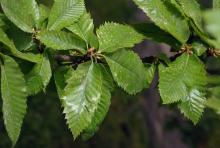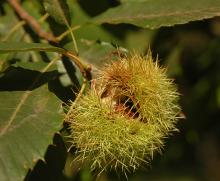Castanea sativa
Common name:
European Chestnut
Sweet Chestnut
Spanish Chestnut
Pronunciation:
kas-TAH-ne-a sa-TI-va, sa-TEE-va
Family:
Fagaceae
Genus:
Type:
Broadleaf
Native to (or naturalized in) Oregon:
No
- Deciduous tree, typically between 40-60 ft (12-18 m) tall but may reach 100 ft (30 m) tall with a spread of 50 ft (15 m) or more; young trees vigorous, having a pyramidal crown and upright shoots; with age lower limbs become massive and spreading. Bark is deeply fissured and spirals up the trunks. Leaves alternate, simple, oblong-lanceolate, 12-22 cm long, rounded or wedge-shaped at the base (sometimes cordate), apex tapering to a point (acute to acuminate), margin with teeth spaced about 1 cm apart, lustrous dark green above, pubescent below when young with glands (small, scruffy scales) near veins, both surfaces are without hairs (glabrous) when mature. Flowers of both sexes are borne in 10-20 cm long, upright, greenish-white catkins, the male flowers in the upper part and female flowers in the lower part. Flowers on a single tree are largely self-incompatible so at least two trees are needed to obtain fully formed nuts. Fruit, usually borne at branch tips, are 5-6 cm wide and have dense prickly hulls and contain 2-5 edible glossy brown nuts.
- Full sun. Does best in sandy, well-drained soil; once established is tolerant of drought. It is resistant to oak wilt fungus but susceptible to chestnut blight but less so than the American Chestnut (Castenea dentata).
- Hardy to USDA Zone 5 Native to southern Europe, northern Africa and southwestern Asia. Long cultivated and naturalized in the British Isles where it is believed to have been introduced by the Romans. Many cultivars have been selected.
- sativa: cultivated
- Portland, Oregon: Hoyt Arboretum
-
Oregon Heritage Tree: #6 Nyberg Chestnut (Castanea sativa)
John Nyberg, an immigrant from Sweden, was a farmer at the turn of the 20th Century. In 1903, he planted an orchard of more than 150 trees, which included several Castanea sativa [Sweet or European Chestnut] trees. But in 1954, when Interstate 5 was being built, the Nyberg home and orchard were located on the highway right-of-way and the home had to be moved and most of the orchard was destroyed. Reportedly John Nyberg had watched as most of the trees were pushed over but then decided to save the last one so he literally stood in front of the D-9 cat and stopped it from bulldozing down the last chestnut tree.
This Heritage Tree, named the Nyberg Chestnut, reached 65 feet tall and 70 feet wide. It was located at the Interstate 5 and Nyberg Road interchange in Tualatin, Oregon in Washington County. The tree died in 2020 and was cut down by the Oregon Department of Transportatiion.









